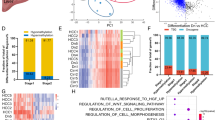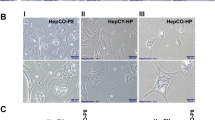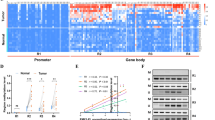Abstract
Aberrant promoter methylation is a fundamental mechanism of inactivation of tumor suppressor genes in cancer. The Ras association domain family 1A gene (RASSF1A) is frequently epigenetically silenced in several types of human solid tumors. In this study, we have investigated the expression and methylation status of the RASSF1A gene in hepatocellular carcinoma (HCC). In two HCC cell lines (HepG2 and Hep3B) RASSF1A was inactivated and treatment of these cell lines with a DNA methylation inhibitor reactivated the transcription of RASSF1A. The methylation status of the RASSF1A promoter region was analysed in 26 primary liver tissues including HCC, hepatocellular adenoma (HCA), liver fibrosis, hepatocirrhosis. Out of 15, 14 (93%) HCC were methylated at the RASSF1A CpG island and hypermethylation was independent of hepatitis virus infection. RASSF1A was also methylated in two out of two fibrosis and in three (75%) out of four cirrhosis; the latter carries an increased risk of developing HCC. Additionally, we analysed the methylation status of p16INK4a and other cancer-related genes in the same liver tumors. Aberrant methylation in the HCC samples was detected in 71% of samples for p16, 25% for TIMP3, 17% for PTEN, 13% for CDH1, and 7% for RARβ2. In conclusion, our results demonstrate that RASSF1A and p16INK4a inactivation by methylation are frequent events in hepatocellular carcinoma, but not in HCA, which is in contrast to HCC without cirrhosis, viral hepatitis, storage diseases, or genetic background. Therefore, this study gives additional evidence against a progression of adenoma to carcinoma in the liver. Thus, RASSF1A hypermethylation could be useful as a marker of malignancy and to distinguish between the distinct forms of highly differentiated liver neoplasm.
This is a preview of subscription content, access via your institution
Access options
Subscribe to this journal
Receive 50 print issues and online access
$259.00 per year
only $5.18 per issue
Buy this article
- Purchase on Springer Link
- Instant access to full article PDF
Prices may be subject to local taxes which are calculated during checkout


Similar content being viewed by others
Abbreviations
- RASSF1:
-
Ras association domain family 1 gene
- HCC:
-
hepatocellular carcinoma
- HCA:
-
hepatocellular adenoma
- FLC:
-
fibrolamellar hepatocellular carcinoma
- LOH:
-
loss of heterozygosity
- 5-Aza-CdR:
-
5-aza-2′-deoxycytidine
- MSP:
-
methylation-specific PCR
- COBRA:
-
combined bisulfite restriction analysis
- PTEN :
-
phosphatase and tensin homologue deleted on chromosome 10
- CDHI :
-
E-cadherin
- RARβ2:
-
retinoic acid receptor beta2
- T1MP3 :
-
tissue inhibitor of metallproteinase-3
- HBV:
-
hepatitis B virus
- HCV:
-
hepatitis C virus
References
Agathanggelou A, Honorio S, Macartney DP, Martinez A, Dallol A, Rader J, Fullwood P, Chauhan A, Walker R, Shaw JA, Hosoe S, Lerman MI, Minna JD, Maher ER and Latif F . (2001). Oncogene, 20, 1509–1518.
Bachman KE, Herman JG, Corn PG, Merlo A, Castello JF, Cavenee WK, Baylin SB and Graff JR . (1999). Cancer Res., 59, 798–802.
Boige V, Laurent-Puig P, Fouchet P, Flejou JF, Monges G, Bedossa P, Bioulac-Sage P, Capron F, Schmit A, Olschwang S and Thomas G . (1997). Cancer Res., 57, 1986–1990.
Burbee DG, Forgacs E, Zochbauer-Muller S, Shivakumar L, Fong K, Gao B, Randle D, Kondo M, Virmani A, Bader S, Sekido Y, Latif F, Milchgrub S, Toyooka S, Gazdar AF, Lerman MI, Zabarovsky E, White M and Minna JD . (2001). J. Natl. Cancer Inst., 93, 691–699.
Clark SJ, Harrison J, Paul CL and Frommer M . (1994). Nucleic Acids Res., 22, 2990–2997.
Cote S, Sinnett D and Momparler RL . (1998). Anticancer Drugs, 9, 743–750.
Dammann R, Li C, Yoon JH, Chin PL, Bates S and Pfeifer GP . (2000). Nat. Genet., 25, 315–319.
Dammann R, Takahashi T and Pfeifer GP . (2001b). Oncogene, 20, 3563–3567.
Dammann R, Yang G and Pfeifer GP . (2001a). Cancer Res., 61, 3105–3109.
Dreijerink K, Braga E, Kuzmin I, Geil L, Duh FM, Angeloni D, Zbar B, Lerman MI, Stanbridge EJ, Minna JD, Protopopov A, Li J, Kashuba V, Klein G and Zabarovsky ER . (2001). Proc. Natl. Acad. Sci. USA., 98, 7504–7509.
Esteller M and Herman JG . (2002). J. Pathol., 196, 1–7.
Feitelson MA, Sun B, Satiroglu Tufan NL, Liu J, Pan J and Lian Z . (2002). Oncogene, 21, 2593–2604.
Flemming P, Wilkens L and Kreipe HH . (2001). Pathologe, 22, 184–190.
Graff JR, Herman JG, Myohanen S, Baylin SB and Vertino PM . (1997). J. Biol. Chem., 272, 22322–22329.
Herman JG, Graff JR, Myohanen S, Nelkin BD and Baylin SB . (1996). Proc. Natl. Acad. Sci. USA, 93, 9821–9826.
Jones PA and Baylin SB . (2002). Nat. Rev. Genet., 3, 415–428.
Jones PA and Taylor SM . (1980). Cell, 20, 85–93.
Kang GH, Lee S, Kim WH, Lee HW, Kim JC, Rhyu MG and Ro JY . (2002). Am. J. Pathol., 160, 787–794.
Khokhlatchev A, Rabizadeh S, Xavier R, Nedwidek M, Chen T, Zhang X, Seed B and Avruch J . (2002). Curr. Biol., 12, 253–265.
Kok K, Naylor SL and Buys CH . (1997). Adv. Cancer Res., 71, 27–92.
Kondo Y, Kanai Y, Sakamoto M, Mizokami M, Ueda R and Hirohashi S . (2000). Hepatology, 32, 970–979.
Lehmann U, Langer F, Feist H, Glockner S, Hasemeier B and Kreipe H . (2002). Am. J. Pathol., 160, 605–612.
Lerman MI and Minna JD . (2000). Cancer Res., 60, 6116–6133.
Li SP, Wang HY, Li JQ, Zhang CQ, Feng QS, Huang P, Yu XJ, Huang LX, Liang QW and Zeng YX . (2001). J. Hepatol., 34, 840–849.
Liew CT, Li HM, Lo KW, Leow CK, Chan JY, Hin LY, Lau WY, Lai PB, Lim BK, Huang J, Leung WT, Wu S and Lee JC . (1999). Oncogene, 18, 789–795.
Liu L, Yoon JH, Dammann R and Pfeifer GP . (2002). Oncogene, 21, 6835–6840.
Lo KW, Kwong J, Hui AB, Chan SY, To KF, Chan AS, Chow LS, Teo PM, Johnson PJ and Huang DP . (2001). Cancer Res., 61, 3877–3881.
Marchio A, Meddeb M, Pineau P, Danglot G, Tiollais P, Bernheim A and Dejean A . (1997). Genes Chromosomes Cancer, 18, 59–65.
Ortiz-Vega S, Khokhlatchev A, Nedwidek M, Zhang XF, Dammann R, Pfeifer GP and Avruch J . (2002). Oncogene, 21, 1381–1390.
Roncalli M, Bianchi P, Bruni B, Laghi L, Destro A, Di Gioia S, Gennari L, Tommasini M, Malesci A and Coggi G . (2002). Hepatology, 36, 427–432.
Roncalli M, Bianchi P, Grimaldi GC, Ricci D, Laghi L, Maggioni M, Opocher E, Borzio M and Coggi G . (2000). Hepatology, 31, 846–850.
Schafer DF and Sorrell MF . (1999). Lancet, 353, 1253–1257.
Schagdarsurengin U, Gimm O, Hoang-Vu C, Dralle H, Pfeifer GP and Dammann R . (2002). Cancer Res., 62, 3698–3701.
Shen L, Ahuja N, Shen Y, Habib NA, Toyota M, Rashid A and Issa JP . (2002). J. Natl. Cancer Inst., 94, 755–761.
Shivakumar L, Minna J, Sakamaki T, Pestell R and White MA . (2002). Mol. Cell. Biol., 22, 4309–4318.
Soria JC, Lee HY, Lee JI, Wang L, Issa JP, Kemp BL, Liu DD, Kurie JM, Mao L and Khuri FR . (2002). Clin. Cancer Res., 8, 1178–1184.
Tomizawa Y, Kohno T, Kondo H, Otsuka A, Nishioka M, Niki T, Yamada T, Maeshima A, Yoshimura K, Saito R, Minna JD and Yokota J . (2002). Clin. Cancer Res., 8, 2362–2368.
Toyooka S, Pass HI, Shivapurkar N, Fukuyama Y, Maruyama R, Toyooka KO, Gilcrease M, Farinas A, Minna JD and Gazdar AF . (2001). Cancer Res., 61, 5727–5730.
Vos MD, Ellis CA, Bell A, Birrer MJ and Clark GJ . (2000). J. Biol. Chem., 275, 35669–35672.
Wilkens L, Bredt M, Flemming P, Becker T, Klempnauer J and Kreipe HH . (2001). J. Pathol., 193, 476–482.
Wistuba II, Behrens C, Virmani AK, Mele G, Milchgrub S, Girard L, Fondon III JW, Garner HR, McKay B, Latif F, Lerman MI, Lam S, Gazdar AF and Minna JD . (2000). Cancer Res., 60, 1949–1960.
Wong IH, Lo YM, Zhang J, Liew CT, Ng MH, Wong N, Lai PB, Lau WY, Hjelm NM and Johnson PJ . (1999). Cancer Res., 59, 71–73.
Xiong Z and Laird PW . (1997). Nucleic Acids Res., 25, 2532–2534.
Zhong S, Tang MW, Yeo W, Liu C, Lo YM, and, Johnson PJ . (2002). Clin. Cancer Res., 8, 1087–1092.
Acknowledgements
This work was supported by NBL3 Grant (FKZ 01ZZ0104) from the BMBF to R Dammann, and by NIH Grant CA88873 to GP Pfeifer.
Author information
Authors and Affiliations
Corresponding author
Rights and permissions
About this article
Cite this article
Schagdarsurengin, U., Wilkens, L., Steinemann, D. et al. Frequent epigenetic inactivation of the RASSF1A gene in hepatocellular carcinoma. Oncogene 22, 1866–1871 (2003). https://doi.org/10.1038/sj.onc.1206338
Received:
Revised:
Accepted:
Published:
Issue Date:
DOI: https://doi.org/10.1038/sj.onc.1206338
Keywords
This article is cited by
-
Identification of DUSP4/6 overexpression as a potential rheostat to NRAS-induced hepatocarcinogenesis
BMC Cancer (2023)
-
Folic acid depletion as well as oversupplementation helps in the progression of hepatocarcinogenesis in HepG2 cells
Scientific Reports (2022)
-
Tumor suppressor genes are differentially regulated with dietary folate modulations in a rat model of hepatocellular carcinoma
Molecular and Cellular Biochemistry (2021)
-
Identification of RASSF1A promoter hypermethylation as a biomarker for hepatocellular carcinoma
Cancer Cell International (2020)
-
Suppressor of hepatocellular carcinoma RASSF1A activates autophagy initiation and maturation
Cell Death & Differentiation (2019)



